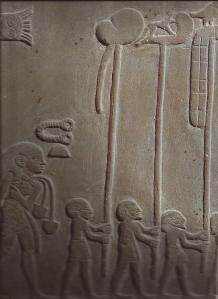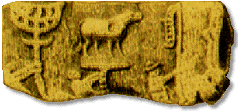( Tamil version of this article is already posted in the blogs: swami )

Picture shows Egyptian standards from Narmer palette
Carrying flags and standards in a king’s procession or God’s (statue) procession is practised even today in India. In Tamil Nadu, the emblems of Shiva or Vishnu are taken in the procession during the annual temple festivals. We are fortunate to have one seal or tablet showing a procession that went through an Indus Valley city thousands of years ago. Egypt has provided us still an older picture of a procession.
Narmer (Nara Meru also known as Menes/Manu) ruled Egypt in the Pre Dynastic period, 5000 years before our time. His palette shows four people carrying standards. The first two carry long poles with bird figures on the top. Next person carried a pole with the wolf God (Wepwawet) and the last one carried a bundle or a cloth. The king is walking behind the sandal bearers.
Indus valley seal of a procession is not complete. We could see only three people carrying three different things. The first one carried a cloth or a festoon like thing hanging from the top of the pole. This is similar to the first two poles of Egypt. The middle one carried a calf (Heifer). This is very clear. Israelites did this till Moses revolted against it. People who have watched films like Ten Commandments may remember the scene of breaking such golden calf statues.
The last person in the Indus procession carried a cult object. Many scholars have identified it with the vessels for extracting Soma Juice. Rig Veda has hundreds of hymns in praise of Soma. A whole Mandala is devoted to Soma Rasa. So it may be something to do with the Soamrasa. A lot of seals with the one horned animas have this symbol. Others think this is a cage with a live bird in it. In Egypt, the first two poles have bird figures. Whatever it may be, there is amazing similarity between Indus Valley and Egyptian standards.

If the cult object is Soma filter or extractor then it must be a Vedic civilization. But nothing is proved beyond doubt. I have made it amply clear in my earlier posts that the Indus civilization was influenced by Middle East and other neighbouring civilizations if we accept the current chronology. A god surrounded by many animals, one hero fighting two animals, the circular stone structures, the snake queen and many others have similarities with older cultures including Minoan civilization.
Please read my other articles on Hindu-Egypt links, Indus Valley seals, Hindu and Tamil flags. Out of my 300 plus articles, there are more than ten posts on Indus Valley and Egypt.

Picture shows Egyptian standards from Narmer palette
Carrying flags and standards in a king’s procession or God’s (statue) procession is practised even today in India. In Tamil Nadu, the emblems of Shiva or Vishnu are taken in the procession during the annual temple festivals. We are fortunate to have one seal or tablet showing a procession that went through an Indus Valley city thousands of years ago. Egypt has provided us still an older picture of a procession.
Narmer (Nara Meru also known as Menes/Manu) ruled Egypt in the Pre Dynastic period, 5000 years before our time. His palette shows four people carrying standards. The first two carry long poles with bird figures on the top. Next person carried a pole with the wolf God (Wepwawet) and the last one carried a bundle or a cloth. The king is walking behind the sandal bearers.
Indus valley seal of a procession is not complete. We could see only three people carrying three different things. The first one carried a cloth or a festoon like thing hanging from the top of the pole. This is similar to the first two poles of Egypt. The middle one carried a calf (Heifer). This is very clear. Israelites did this till Moses revolted against it. People who have watched films like Ten Commandments may remember the scene of breaking such golden calf statues.
The last person in the Indus procession carried a cult object. Many scholars have identified it with the vessels for extracting Soma Juice. Rig Veda has hundreds of hymns in praise of Soma. A whole Mandala is devoted to Soma Rasa. So it may be something to do with the Soamrasa. A lot of seals with the one horned animas have this symbol. Others think this is a cage with a live bird in it. In Egypt, the first two poles have bird figures. Whatever it may be, there is amazing similarity between Indus Valley and Egyptian standards.

If the cult object is Soma filter or extractor then it must be a Vedic civilization. But nothing is proved beyond doubt. I have made it amply clear in my earlier posts that the Indus civilization was influenced by Middle East and other neighbouring civilizations if we accept the current chronology. A god surrounded by many animals, one hero fighting two animals, the circular stone structures, the snake queen and many others have similarities with older cultures including Minoan civilization.
Please read my other articles on Hindu-Egypt links, Indus Valley seals, Hindu and Tamil flags. Out of my 300 plus articles, there are more than ten posts on Indus Valley and Egypt.
